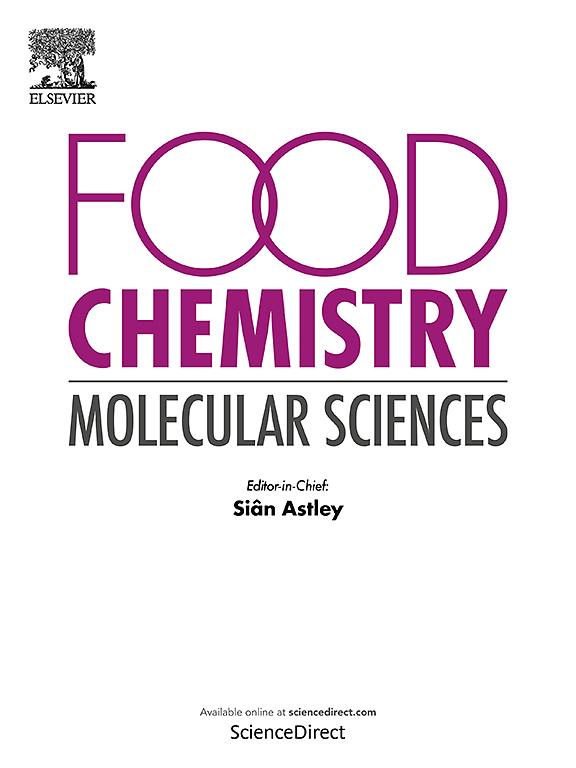Metabonomic and transcriptomic profiling reveals amino acid metabolism affects the quality of premium japonica rice varieties in Northeast China
IF 4.1
Q2 FOOD SCIENCE & TECHNOLOGY
引用次数: 0
Abstract
Rice consumption and demand for premium rice are increasing worldwide. However, the characterizations and how to identify the premium rice are still unclear. Small molecular metabolites have a great advantage in distinguishing subtle differences among similar agricultural products. So, we hypothesized that the metabolites would be the key to identifying the tiny differences in premium rice among similar varieties. In this study, we performed metabolomic and transcriptomic profiles to comprehensively elucidate key metabolites, genes, and formation mechanisms of premium rice. As a result, eight compounds belong to four categories, and 49 different expressional genes were identified in premium rice varieties after comparing with the second-best varieties. Moreover, the integrated analysis confirmed that the amino acid pathway, including 42 expression genes and 11 metabolites, was critical for the premium rice formation. Six genes and two metabolites had significant regulatory effects on the pathways. Furthermore, amino acid quantification confirmed the content of 12 kinds of hydrolytic amino acids, such as aspartic acid and arginine were different between premium and other varieties. These amino acids may serve as potential biomarkers for differentiating premium rice in Northeast China. Our results strongly support the possibility of differentiating premium rice and would provide essential data for premium rice identification and metabolomics-assisted breeding.
代谢组学和转录组学分析揭示氨基酸代谢对中国东北优质粳稻品种品质的影响
全世界的大米消费量和对优质大米的需求都在不断增长。然而,优质大米的特征和鉴别方法仍不明确。小分子代谢物在区分同类农产品的细微差别方面具有很大优势。因此,我们假设代谢物将是识别优质大米在同类品种中微小差异的关键。在这项研究中,我们进行了代谢组学和转录组学分析,以全面阐明优质大米的关键代谢物、基因和形成机制。结果发现,与次优品种相比,优质水稻品种中的 8 种化合物分属 4 个类别,49 个表达基因各不相同。此外,综合分析证实,氨基酸途径(包括 42 个表达基因和 11 种代谢物)对优质稻米的形成至关重要。有 6 个基因和 2 个代谢物对该途径有显著的调控作用。此外,氨基酸定量分析证实,天门冬氨酸、精氨酸等 12 种水解氨基酸的含量在优质稻和其他品种之间存在差异。这些氨基酸可作为区分中国东北优质稻米的潜在生物标志物。我们的研究结果有力地支持了区分优质水稻的可能性,并将为优质水稻鉴定和代谢组学辅助育种提供重要数据。
本文章由计算机程序翻译,如有差异,请以英文原文为准。
求助全文
约1分钟内获得全文
求助全文
来源期刊

Food Chemistry Molecular Sciences
Agricultural and Biological Sciences-Food Science
CiteScore
6.00
自引率
0.00%
发文量
83
审稿时长
82 days
期刊介绍:
Food Chemistry: Molecular Sciences is one of three companion journals to the highly respected Food Chemistry.
Food Chemistry: Molecular Sciences is an open access journal publishing research advancing the theory and practice of molecular sciences of foods.
The types of articles considered are original research articles, analytical methods, comprehensive reviews and commentaries.
Topics include:
Molecular sciences relating to major and minor components of food (nutrients and bioactives) and their physiological, sensory, flavour, and microbiological aspects; data must be sufficient to demonstrate relevance to foods and as consumed by humans
Changes in molecular composition or structure in foods occurring or induced during growth, distribution and processing (industrial or domestic) or as a result of human metabolism
Quality, safety, authenticity and traceability of foods and packaging materials
Valorisation of food waste arising from processing and exploitation of by-products
Molecular sciences of additives, contaminants including agro-chemicals, together with their metabolism, food fate and benefit: risk to human health
Novel analytical and computational (bioinformatics) methods related to foods as consumed, nutrients and bioactives, sensory, metabolic fate, and origins of foods. Articles must be concerned with new or novel methods or novel uses and must be applied to real-world samples to demonstrate robustness. Those dealing with significant improvements to existing methods or foods and commodities from different regions, and re-use of existing data will be considered, provided authors can establish sufficient originality.
 求助内容:
求助内容: 应助结果提醒方式:
应助结果提醒方式:


